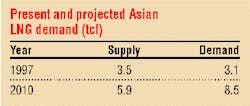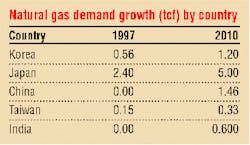Irian Jaya stranded gas accumulation revived after 42 years
The recent economic crisis in Southeast Asia is turning around, evidenced by the 62% increase in the composite of Asian stock markets in 1999. This bellwether statistic indicates the return of historic economic growth rates and attendant growth in energy consumption.
Another interesting statistic is that LNG consumption in Japan increased by 4.8% from 1997 to 1998, in spite of a negative GDP in 1998. With a return to historic economic growth rates, LNG demand in Japan will increase 6-7% per annum.
At one time, Japan had ambitious plans to increase nuclear power generation. The recent spate of nuclear accidents has emboldened an already powerful anti-nuclear movement in Japan to develop a "Three Mile Island" mentality. Only two nuclear plants are under construction and officials privately concede that it is unlikely any new plants will be constructed in the next 10 years.
These factors will severely limit nuclear power's future role in Japan. Nuclear power's loss is a gain for natural gas. The number of Japanese gas customers has increased 25% in the past ten years led by industry's use of cheaper power and the desire for "green" energy. Japan is planning a large expansion of its gas pipeline infrastructure, which is presently limited to the Tokyo region.
China and India
The wild cards in predicting Asian LNG demand are China and India. The Chinese economy adds 50 million jobs a year. It may soon join the World Trade Organization and further privatize its economy. The US Energy Information Administration predicts China will import 1.1 tcf per year of LNG by 2010. Other industry players believe this number could be 1.5 tcf.
India is presently constructing its first LNG import terminal and is projected to increase LNG consumption to a minimum of 0.5 tcf a year by 2010. Coupled with Japan's increased LNG usage, this level of growth will cause the development of previously stranded gas resources throughout the Pacific region.
Forgotten frontiers
As early as 1916, an exploration survey sampled a significant oil seep in Teer River Valley situated immediately east of the Rombebai Block in Irian Jaya, Indonesia. Analysis revealed the seep produced 30° API crude oil. In 1935, the first exploration rights over what is now the Rombebai Block were granted to Nederlandsche Nieuw Guinee Petroleum Maatschappij (NNGPM) a Royal Dutch Shell company. In 1958, NNGPM drilled the Niengo #1 well, located on the north coast of New Guinea Island.
The Niengo #1 encountered a 1,000-ft gas column and electric logs demonstrated 330 ft of net gas pay. A drill stem test over a 35-ft interval flowed 4.5 MMcf/d of methane gas (99.2% pure) to surface with a calculated absolute open flow rate exceeding 60 MMcf/d, indicating good reservoir deliverability. No market was identified and the license was relinquished when The Netherlands ceded Irian Jaya to Indonesia in 1960.
In the 1980s, Shell returned to northern Irian Jaya and conducted an extensive seismic program. Several seismic lines crossed the Niengo #1 well location and subsequent mapping revealed a 35-km by 10-km anticlinal structure that significantly extended offshore. This recent seismic provided convincing evidence that the 1958 Niengo discovery was a potential 7-10 tcf gas accumulation.
Shell concentrated future efforts on several promising oil prospects that revealed additional gas resources. Once again, Shell relinquished their interest due to the lack of live oil.
In 1996, Arco led a group in the discovery and delineation of the Wiriagar and Vorwata gas fields that ultimately proved up 13 tcf of natural gas. Located in Bintuni Bay, these gas accumulations will justify the construction and development of the Tangguh LNG project. The Tangguh LNG plant will also be available to take gas from other suppliers similar to the Badak LNG project in East Kalimantan, which liquefies natural gas from multiple PSC's. Finally, a market for Irian Jaya gas is apparent.
Recent history
The Rombebai Block Production Sharing Contract (PSC), located in Irian Jaya (recently renamed West Papua), was signed by Ramu International LLC (Ramu) and Pertamina in November 1998, as part of the 1993 petroleum incentive package for Eastern Indonesian frontier areas.
The Rombebai PSC enjoys the frontier fiscal terms that guarantee 40% contractor take of gross revenues from gas sales - the best fiscal terms available in Indonesia. It covers 11,590 sq km and lies offshore/onshore in the Waipoga Basin of Irian Jaya. Ramu's new exploration program rejuvenates an area that has undergone sporadic petroleum exploration for nearly 100 years. This renewed effort by Ramu will culminate in the development of multiple trillions of cu ft of natural gas.
Based on reprocessing of the Shell 1980 seismic data, Ramu has generated a drillable location offsetting the 1958 Shell Niengo #1 gas discovery. The Niengo #2 will be drilled at a location structurally up-dip and 8 km northwest of the original discovery. In combination with the Arco discoveries, a once stranded resource at Rombebai will serve the growing gas markets of Asia.
Geology, tectonic setting
The Rombebai Block lies in the onshore/offshore portion of the Waipoga Basin. The depositional axis trends east-west and the basin is bounded to the south by the North Divide Range and to the north by the Mamberamo Basement Uplift. The major tectonic element that formed the Waipoga Basin is the convergence between the Carolina Oceanic Plate and the northern New Guinea margin.
The compression was initiated during the early Pliocene and uplifted the North Divide Range to the south while the Waipoga Basin formed to the north. Throughout the Pliocene and Pleistocene, the basin was a deep depocenter that filled very rapidly with predominantly clastic materials shed from the uplifting mountains to the south. Sediments were rapidly deposited into an outer neritic-to-bathyal setting by a turbidite system, ultimately attaining a thickness of 7,500 meters. By the latest Pleistocene, the basin shallowed and was inverted.
An additional key tectonic feature of the Rombebai Block is the Yapen Fault zone, which is a left lateral strike-slip fault and part of the larger Sorong Transform Fault system. The fault zone crosses the block east to west and is identified by a dramatic line of mud volcanoes that follow the fault trace for approximately 90 km.
A pre-existing basement feature controls the Niengo structure. The Plio-Pleistocene Mamberamo Form ation serves as the gas reservoir. The gently draped Mamberamo Formation forms a laterally extensive trap overlying the 350 sq km anticline.
Gas source
Biogenic gas comprises over 25% of all the known natural gas reserves in the world, not including the deepsea hydrates. The Po Valley Basin in central Italy is an excellent analog to the Rombebai Block and has over 28 tcf of proven biogenic methane reserves that were generated from Pliocene sediments.
The depositional and tectonic setting of the Waipoga Basin of Irian Jaya and the Po Valley Basin of Italy are nearly identical. All of the recovered and documented hydrocarbons in the Rombebai Block are biogenic methane gas.
The source of the gas is anaerobic bacteria that convert the abundant organic material shed into the Waipoga Basin into methane solution gas. Conditions that favor the generation of biogenic methane gas are:
- Rapid sedimentation into bathyal water depths
- Abundant organic material
- Absence of sulfates from evaporites
- Low temperature/low geothermal gradients. Anaerobic bacteria function in a temperature window of 35-100° C.
These conditions prevailed in the Waipoga Basin during Plio-Pleistocene time. Initially, the biogenic methane is in solution rather than in the gaseous phase. When pressure conditions are decreased with the rapid uplift associated with the anticline, the methane in solution ex-solves, and gas enters into the system. Buoyancy forces drive the gas up-dip into a trap or to the surface. The significant uplift during the latest Pleistocene to Recent in the Waipoga Basin decreased the pressure conditions in the Plio-Pleistocene section, resulting in massive exsolution of methane gas.
The Rombebai Block has undergone sporadic exploration over the past 85 years and significant gas reserves are clearly indicated. A limiting factor in the development of these vast gas reserves has been the lack of markets.
The rapidly developing demand for clean burning natural gas in Southeast Asia will unlock the resources of this area. The reserves are too big and too accessible to be ignored and left unproductive in the new millennium.

